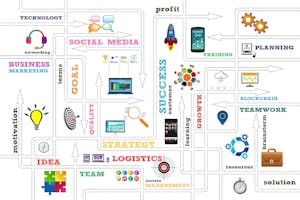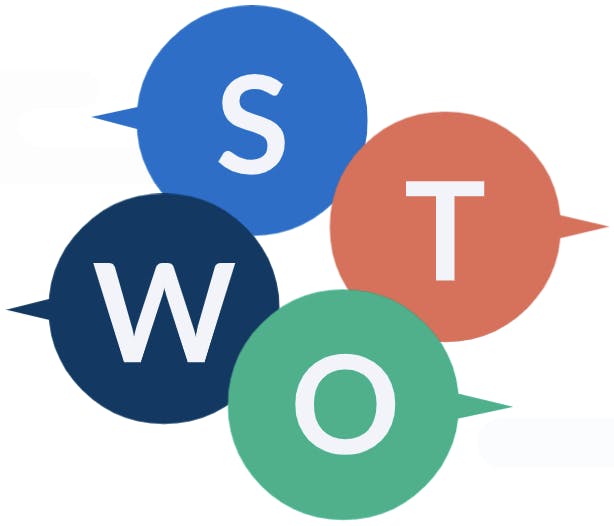- 50 minutes
- Digital Marketing
Sojern Presents: Data-Driven Strategies To Boost Your Marketing and Increase Ticket Sales
All Skill Levels
Get a behind-the-scenes-look into FareHarbor's 2024 season

Creating a digital marketing strategy from scratch can seem time-consuming, and you might be tempted to start implementing tactics before developing a full plan, but having a clear strategy is the first step toward achieving your marketing goals.
A digital marketing strategy outlines how your company’s strategic objectives will be achieved through specific marketing tactics. The starting point of every marketing strategy should always be the customer and their journey to doing business with you (more on that later). A few important components of your digital marketing strategy are:
This step-by-step guide will walk you through these components and help you craft your own digital marketing strategy!
The first step of your digital marketing strategy should be to conduct an internal audit of your company’s goals and objectives and analyze your business model and industry landscape. That sounds like a lot, so let’s break it down.
SWOT stands for strengths, weaknesses, opportunities, and threats. The purpose of this type of analysis is to determine what your company does well, where you need to improve, and what kinds of opportunities and threats face your industry as a whole.
 A SWOT analysis can apply to various aspects of your business, but for now, let’s focus on how it relates to and can help with your digital marketing strategy. Think about where your company stands in the digital space. Can customers easily find you online? Is your website optimized for user experience? Are you active on social media? As you’re conducting your analysis, keep these questions in mind to help you understand where you are, where you want to go, and what obstacles or opportunities you might encounter along the way.
A SWOT analysis can apply to various aspects of your business, but for now, let’s focus on how it relates to and can help with your digital marketing strategy. Think about where your company stands in the digital space. Can customers easily find you online? Is your website optimized for user experience? Are you active on social media? As you’re conducting your analysis, keep these questions in mind to help you understand where you are, where you want to go, and what obstacles or opportunities you might encounter along the way.
Sit down and write some points in each column — strengths, weaknesses, opportunities, and threats — to get a better idea of what your goals are and how your digital marketing strategy can help you accomplish them.
Now that you have an understanding of where your company and your industry stand, it’s time to decide on the goals that will determine the direction of your digital marketing strategy. Start with the big picture: What is the core mission of your business? With that in mind, decide on your broad goals, like increasing your online visibility and sales. From there, narrow it down to detailed and measurable goals. We’ll go more in-depth on measurable goals in a moment. At this stage, think big and decide on the main areas you want to focus on (i.e. increasing conversions on your website, boosting engagement on your social media channels, etc.).
As a business owner, you probably already have a pretty good idea of who your core audience is, whether that’s based on your top-selling activity types, your location, etc. Talk to your tour operators to get a clearer idea of who your customers are: i.e. families on vacation with kids, locals looking for fun things to do in town, overseas tourists, etc.
Once you have identified your customers, you can create a customer persona, a semi-fictitious generalization or representation of your core customers and target market. The best digital marketing strategies have clear, granular customer personas to ensure that the marketing efforts are targeted, effective, and efficient. It takes time to develop these personas, so if you’re diving into it for the first time, just focus on taking the first steps, knowing it will be a work in progress that continues to evolve.
To get started on developing your customer personas:
 Pro tip: The Acquisition tab in Google Analytics is a great place to start. It tells you where your clients are coming to your website from, such as search engine searches, social media links, direct searches, etc. Our guide to Google Analytics dives deeper into GA’s capabilities, and learn more about mapping your customer’s journey on this FH blog!
Pro tip: The Acquisition tab in Google Analytics is a great place to start. It tells you where your clients are coming to your website from, such as search engine searches, social media links, direct searches, etc. Our guide to Google Analytics dives deeper into GA’s capabilities, and learn more about mapping your customer’s journey on this FH blog!
We realize you might not have the time or resources to dive deep into customer personas, but giving some thought to your core audience will help you determine how to reach them to achieve your digital marketing goals. If you’re serious about developing in-depth personas, check out this guide on branding.
Once you have a better understanding of who your customers are and what their digital journey looks like, you can utilize tools and resources like Google Analytics and your FareHarbor Dashboard to determine what channels (social media, organic search, online advertising, etc.) are your top performers. These are the channels that get you the most traffic, revenue, or conversions. You can also identify which channels are underperforming.
One purpose of this step is to determine where you want to focus your digital strategy and allocate your time and resources. You might decide to invest in your underperforming channels to bring them up to the level of your other channels, or you might prefer to focus on reinforcing the channels that perform best for your business.
The other purpose of this step is to understand the relationship between your various channels. For example, a customer might see an ad, which then prompts them to look up your company in a search engine.
This is a good time to think about the budget for your marketing campaign. If you’re planning on spending some money on your marketing efforts, think about which channels you want to allocate funds to. Once you’ve identified what channels you want to focus on, head to the next step!
Now that you’ve identified the focal points of your customer journey, it’s time to develop your content strategy. Posting content here and there, whether it’s blog posts or social media campaigns, can feel aimless when you don’t have a clear purpose for each piece of content. By developing all your content in advance, you can be sure that it’s all working toward your digital marketing goals.
A content strategy also makes your life easier when it’s time to start publishing that content because it’s already been drafted and you know it’s consistent and has a purpose. Some things to keep in mind when you’re developing your content strategy:
There are a few important components that will help your content strategy succeed:
If your digital marketing goal is to be discovered in search engines, keyword research will be crucial to your strategy’s success. Identify the appropriate keywords to use in your content to organically improve your SEO, and think about the type of content that you can provide around those keywords that will be valuable to your customers. Learn more about keyword tips and tricks and suggestions for helpful, fun free tools you can use to find them.
Before you begin drafting new content, it’s a good idea to run an audit on your existing content to assess what has performed well in the past and what hasn’t. Using tools like Google Analytics or the analytics tools built into social media platforms, you can gauge what your customers like and tend to engage with. For example, if you got a ton of engagement on that video you posted on Facebook that showed the river where your kayak tours take place, think about other videos that would align with your digital marketing strategy.
Whether you’re creating ads, blog posts, or social media posts, you want to ensure you use a consistent brand voice and tone that reflects the personality of your company. Is your company casual and witty? Elegant and luxurious? Warm and welcoming? Depending on the feel or vibe of your company, you can create a signature style of content that is unique to you.
Your brand voice gives your customers an idea of who you are and what type of experience they’ll have with you. Whatever tone you choose, just ensure it’s consistent throughout all of your content, and make sure it remains professional no matter what.
Once you’ve planned out and drafted the pieces of content you’ll need for your digital marketing campaign, schedule out the days and times when you want to publish your posts. If you’re blogging on a platform like WordPress, you can schedule your posts for specific dates. If you’re posting on social media, some platforms like Facebook allow you to schedule your posts in advance, while others will require a social media dashboard like Buffer or Hootsuite.
Putting together a roadmap that details when and where you’ll be posting your content will help you understand where each piece fits into the overall campaign and will ensure that you don’t have long stretches of time when you’re not posting anything or days when you’re overwhelming audiences with content.
Keep your target audience in mind when you’re planning out your content schedule. When are they likely to be on their desktops or phones consuming content? You can use Google Analytics to check on traffic patterns on your website and decide on the best time to publish new content. For some common traffic patterns, check out our blogging guide.
It’s important to diversify your content and craft different pieces of content for different platforms. What works well as a blog post probably won’t work as well on social media. Think about the different ways that you can present the same information on different platforms. For example, you can publish a blog post on your website and complement it with great photos on Instagram. Remember that each platform has different audiences who have unique interests. Keeping your goals in mind will help you decide what types of content you need to create.
For more on creating content that your readers and search engines will love, check out our content guide.
At this point, you’ve developed your strategy and are ready to start running your digital marketing campaigns, but the work isn’t over yet. This next step is arguably the most important: measuring your results.
To truly understand the impact of your campaign, you need to set KPIs (key performance indicators), quantifiable goals that help you measure the success of your digital marketing strategy. What you want to measure will depend on your goals. If you want to increase online visibility, you might set a goal related to click-through rates or social media engagement. If your goal is to increase online sales, you might set a dollar amount you want to hit.
This step is all about setting an expectation and having a quantifiable way to assess how your campaign is performing. Digital marketing strategies can always change and be optimized. Data and analytics are the pillars for understanding and making the adjustments in tactics or budget needed to make the most out of your campaign.
If you’re a new business or are just dipping your toes in marketing, it might be difficult to identify what KPIs are right for your strategy. A helpful concept to keep in mind is SMART goals: goals that are specific, measurable, achievable, relevant, and time-bound. You might have a goal of increasing your conversions from Facebook ads. To turn this into a SMART goal, you need to narrow it down to something like “increase conversions by 10% within the next six months.” This type of goal helps you identify exactly what you need to work on to achieve it.
 Pro tip: To create a baseline for your KPIs, it’s a good idea to test out your marketing campaigns for three months first. After the three months, you’ll have plenty of data to go off of, and you can choose the metrics you want to focus on and set your KPIs around them.
Pro tip: To create a baseline for your KPIs, it’s a good idea to test out your marketing campaigns for three months first. After the three months, you’ll have plenty of data to go off of, and you can choose the metrics you want to focus on and set your KPIs around them.
Create a schedule for checking the results of your campaigns. One of the benefits of digital marketing is that you’re getting data in real time, whether it’s clicks to your site or engagement on social media. Set a reminder to review performance and analytics in a timeframe that works for your campaign, whether that’s weekly, monthly, or quarterly.
A word of caution: Although you should use performance data and analytics to make optimizations to your campaigns and tactics as needed, it’s a good idea to space out the changes you make and document them carefully. If you make too many changes too quickly, it can be difficult to assess what worked and what didn’t. Give your campaigns some time to show you if they’re working or not, gather the performance data, and then make changes as needed.
Once you’ve done the work to create a digital marketing plan, it’s important to continue to revise it as needed. Your goals and tactics can change over time to accommodate new business objectives, new technologies, etc. Adaptability is one of the most important skills in the world of digital marketing. Stay up to date on the changes and innovations in your industry as well as the tools you use to market your business. Now that you have a solid plan to work from, it will be much easier to make adjustments as you go.
Ready to dive into more specific digital marketing tactics? Check out our other marketing guides!